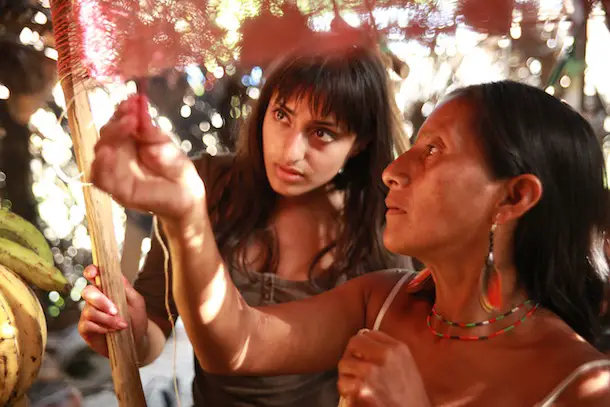Last week saw the premier of Earth 2.0 – Initialization in London – the first in a series of promotional films pitched as a ‘conversation-starter’ on how we create an eco-friendly future for our densely populated planet. A question and answer session followed the film, offering those present a deeper insight into the goals of Earth 2.0. Present to answer the audience’s questions were Graham Hancock – writer, presenter and journalist, Simon G. Powell – author and Earth 2.0’s principal scriptwriter, Rachel Armstrong – TED Fellow, and Melissa Sterry – developer of The Bionic City.
Audience Question: It’s fantastic to see such a positive platform for the future, but I’ve got a question about failure. I’m curious to know how you think Earth 2.0 will encourage people to fail fast? And how will it support the sharing of lessons learned and best practice?
RA: That’s a really important question which feeds completely into the notion of an experimental laboratory. You only know if it’s real science if it doesn’t work most of the time, and I absolutely agree with you. How can we start engaging with the experiments without pre-judging the outcomes, and start to really observe what is happening? Being honest, objective, facilitative and participatory, giving new projects space to breath. How do we create this experimental space which is more exploratory than goal orientated, which is exactly what we’ve got when we try to develop sustainable technologies. We go shooting down rabbit holes, looking for the thing that we’ve already identified at the end.
Q: Have you in your travels come across an enabling technology which could make a massive difference to humanity, but it hasn’t been implemented?
MS: I was having a discussion the other day about why innovation doesn’t break through, and it comes down to one thing – vested interest. We could all be using free or practically free renewable energy, for instance. And there’s one simple reason why we’re not – the vested interest of the energy companies. For pharmaceutical companies, it’s in their interest that some of us are ill. A typical thing they do is buy up patents for groundbreaking drugs, and remove them from the marketplace. Vested interest is a problem. I know of one example – it’s a cure for heroin and crack addiction. One international government has made a cure, and when they went to the pharmaceutical companies, they said they would buy it on the condition they could have all the patents, and of course one of the reasons for this is they own the patents for the drugs such as Methadone that people stay on. But one of the disruptive enablers that is helping innovation to get through is crowd sourcing, projects like this where people get together and say they’re going to make it happen come what may. People power is coming back, and to gauge how powerful it is, look at what is happening in the Middle East. Regimes that were robust for decades are falling like flies. If we can see that happening with innovation, we’re going to see some great stuff happen.
SP: The changes that we need aren’t going to come from governments and politicians, they are going to come from the media. That is why Earth 2.0 is setting itself up as a 360 media tool, creating a two-way conversation.
Q: We live in a country where Jeremy Clarkson’s opinions are listened to more than the intelligent people who run the planet. How are you going to make sure you are heard?
SP: We’re just going to have to make a noise, get as much attention as we can. Everyone is trying to get attention, there is competition for attention.
GH: The Daily Mail I must say is a huge negative force within our society, and it is representative of the state of mind of a large proprtion of the media. I think that things are beginning to change, and again, the internet and different forms of communication are breaking the power of those big publishing corporations. And once the power of those big corporations is broken, I mean, consider books, where the power of the publishing industry is really in the manufacture and distribution of those physical books, that’s what makes them powerful. At a stroke, electronic reading and the internet are going to remove their powers, creating a new situation where people are talking to each other. I’m quite optimistic that those media dinosaurs are nearing the end of their life.
RA: I would also say that we need the participation of children, because they aren’t so… they don’t know what the word impossible means. I think engaging and tapping into the narratives that children create for their futures, and actually listening to their fears, hopes and dreams will allow us to connect with a huge future potential.
Q: It sounds like you are creating a hub here, a platform which people can talk on, and suggest ideas. So what I would like to know is, what is the hub? And how do we get involved?
MS: Something I think is unique about what we are doing is the appeal to all ages. We’ve rolled this out to 7 year olds and 70 year olds. We’ve had responses we haven’t seen for a long time. What we’re trying to create is Tomorrow’s World meets Avatar – a fusion of science fiction and science faction. We aim to make a feature film to get this out there, and we’re developing a web platform. We are looking at the potential to evolve this is an online centre of information, and beyond this we are looking to create a foundation. When you look at media, other than film, there aren’t many places where you can look for the most out-there ideas. You certainly aren’t going to read it in the Daily Mail. In fact, a lot of what you read is poorly researched. Anyone who’s had a surfing lesson knows that floating cities won’t work, but trying to get funding for the scientifically grounded, yet still challenging ideas is nearly impossible. In fact, it’s the only thing that is impossible!
Photo: Iva Rajovic


